Meta Description Example Length and Best Practices
Apr 04, 2025
Written by Casey Bjorkdahl

Casey Bjorkdahl is one of the pioneering thought leaders in the SEO community. In 2010, Casey co-founded Vazoola after working for a Digital Marketing Agency for five years in New York City. Vazoola is now one of the fastest growing and most widely recognized SEO marketing firms in the country.
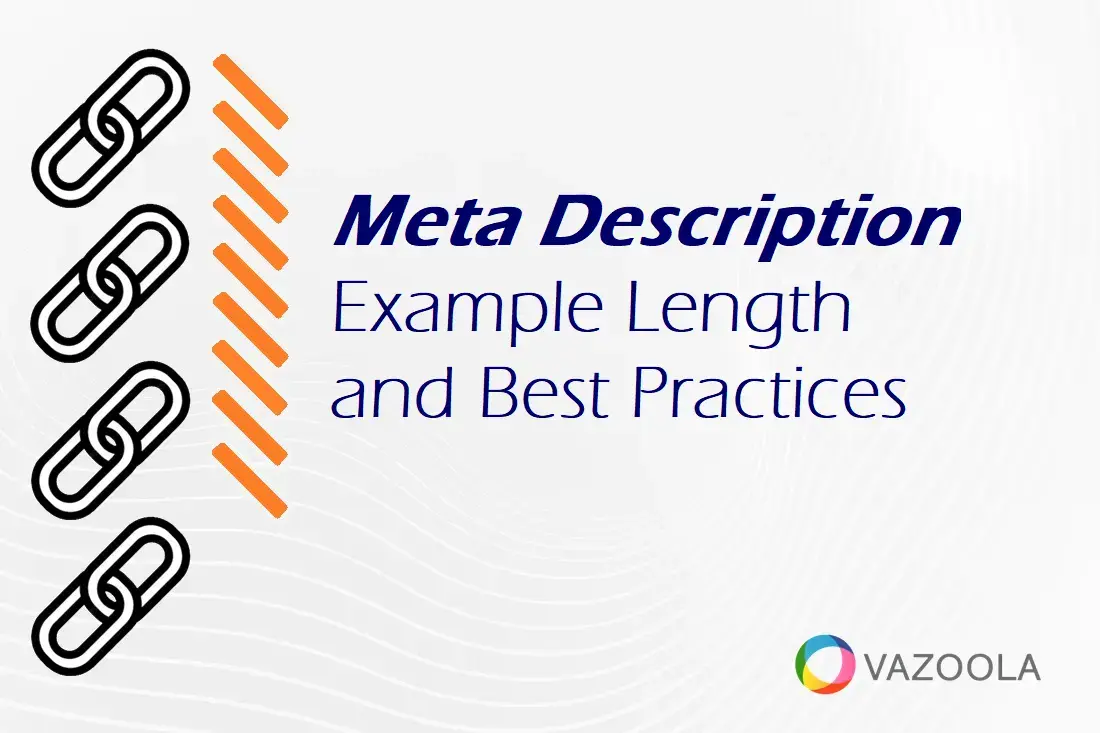
Think about when you’re searching for something online. You probably rely on two key elements to decide which link to click: the title (known as the “title tag” in the content business), and meta description (the blurb beneath the title).”
Title tags do tend to grab attention, but it’s the meta descriptions that provide the context that persuades users to engage with the site. A well-crafted meta description can indirectly increase certain SEO metrics. It significantly boosts click-through rates, which in turn leads to higher engagement and more website traffic.
Google does not use meta descriptions as a direct ranking factor. But that doesn’t mean they can’t affect SEO – their impact on search behavior, in fact, is undeniable. Poorly written or missing meta descriptions can reduce traffic, but a strong, compelling snippet will encourage users to take action.
Of course, there are plenty of poorly written meta descriptions out there. In fact, an Ahrefs study of meta descriptions for 20,000 keywords found that Google rewrites meta descriptions two-thirds of the time!
Are you ready to write meta descriptions that draw traffic to your site? You’ll want to take into account some best practices, guidelines, and tools or generators to help you meet your goals.

Drive clicks with emotional triggers. Use words that evoke curiosity, urgency, or excitement. Phrases like "Don’t make this common SEO mistake" or "Here’s what experts don’t tell you about SEO" can improve engagement.
Key Takeaways
-
A well-crafted meta description improves click-through rates, which leads to more traffic.
-
Search engines do not use meta descriptions as a ranking factor, but a strong description indirectly supports SEO.
-
Keep meta descriptions between 150–160 characters to avoid truncation.
-
Meta descriptions should be relevant, specific, and include a compelling call to action.
-
Several tools can help optimize meta descriptions, including AI-powered generators.
Table of Contents
What Is a Meta Description?
When someone performs a search, they see a title tag followed by a brief summary of the page content. This summary is known as the meta description. It’s an HTML attribute that provides a short snippet of details about a web page.
The meta description appears under a website’s title and URL in search results. It can greatly influence whether or not a user will click through to the page.
Granted, search engines like Google don’t always display the meta description that was manually written. But a well-crafted HTML meta description still increases the chances that users will engage with the link.
Here is one of our homepage meta description examples.

How Do Meta Descriptions Affect SEO?
Meta descriptions are not direct ranking factors with Google, but they do have an indirect impact because they significantly influence CTRs. A compelling description helps searchers understand a page’s value before they click to it.
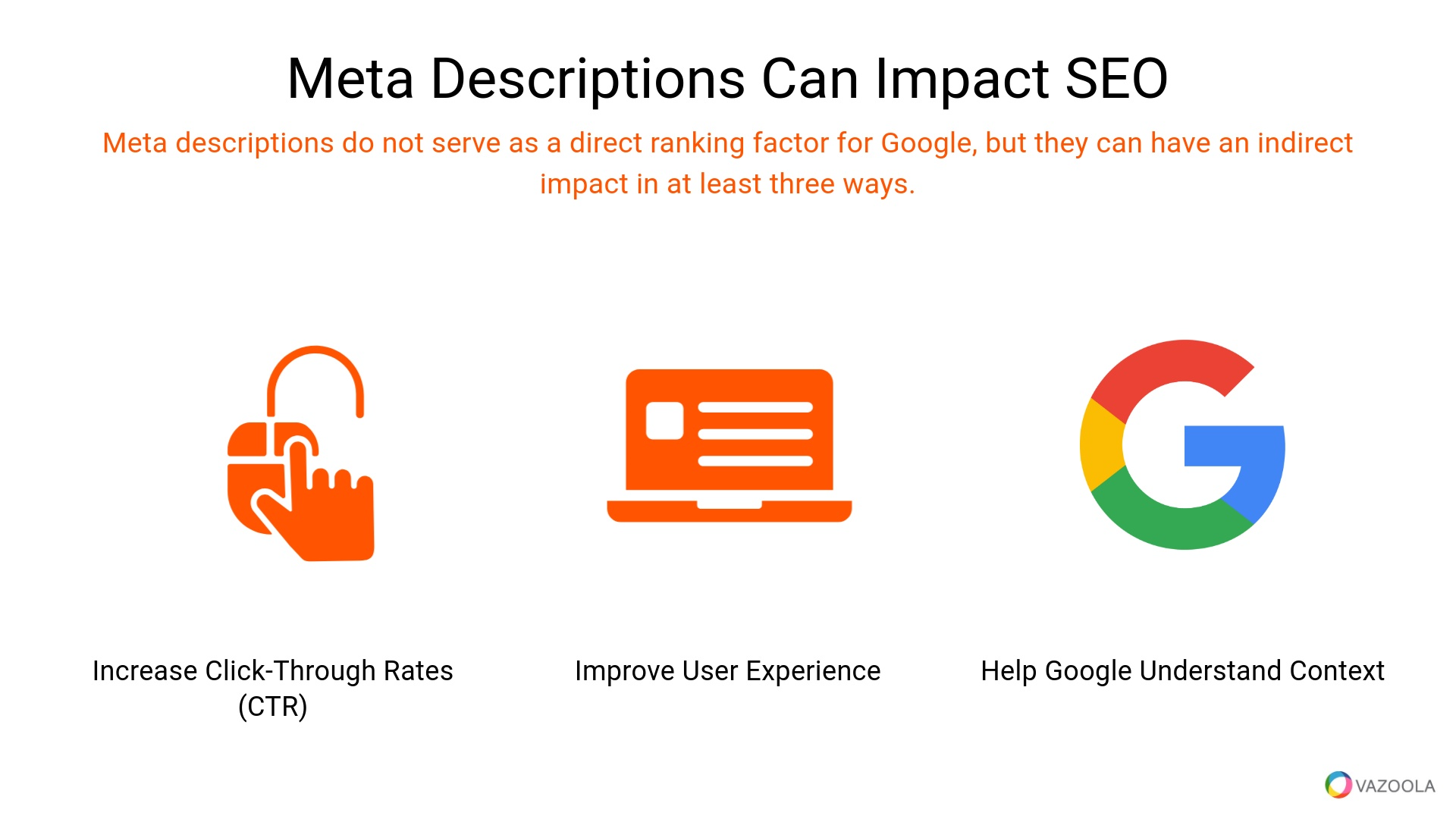
According to a Moz study, meta descriptions can indirectly impact rankings by increasing the organic click-through rate. The CTR is a sign of relevance and engagement to search engines.
Here’s how meta descriptions can help your website’s performance:
-
Increase CTR: Users are more likely to click on a link if the description is clear and engaging.
-
Improve User Experience: A well-written description sets clear expectations about the page’s content.
-
Help Google Understand Context: While it’s not a ranking factor, a meta description can reinforce keyword relevance.
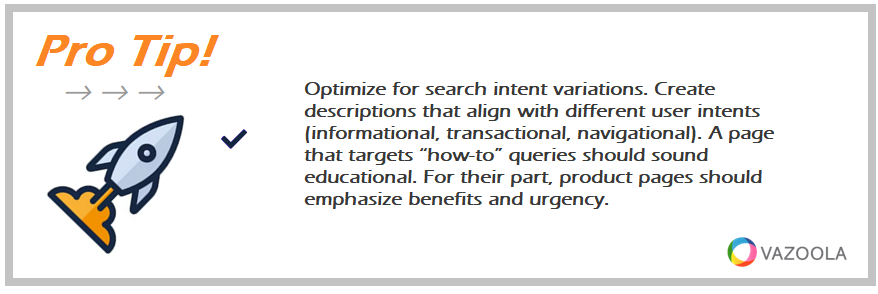
Optimize for search intent variations. Create descriptions that align with different user intents (informational, transactional, navigational). A page that targets “how-to” queries should sound educational. For their part, product pages should emphasize benefits and urgency.
How To Write a Meta Description
Do you know how to write meta descriptions?
If you want to write an effective meta description, you need to be precise. Here are some best practices to follow:
-
Include Target Keywords at the Start – Users skim search results quickly, so placing keywords at the beginning improves visibility.
-
Use a Call to Action – Encourage clicks with phrases like "Learn more," "Find out how," or "Get started today."
-
Match the Page Content – Misleading descriptions can harm credibility and result in higher bounce rates.
-
Be Specific and Informative – Tell users exactly what they’ll get by clicking on the link.
-
Keep It Concise – Shoot for 150–160 characters to prevent truncation in search results.
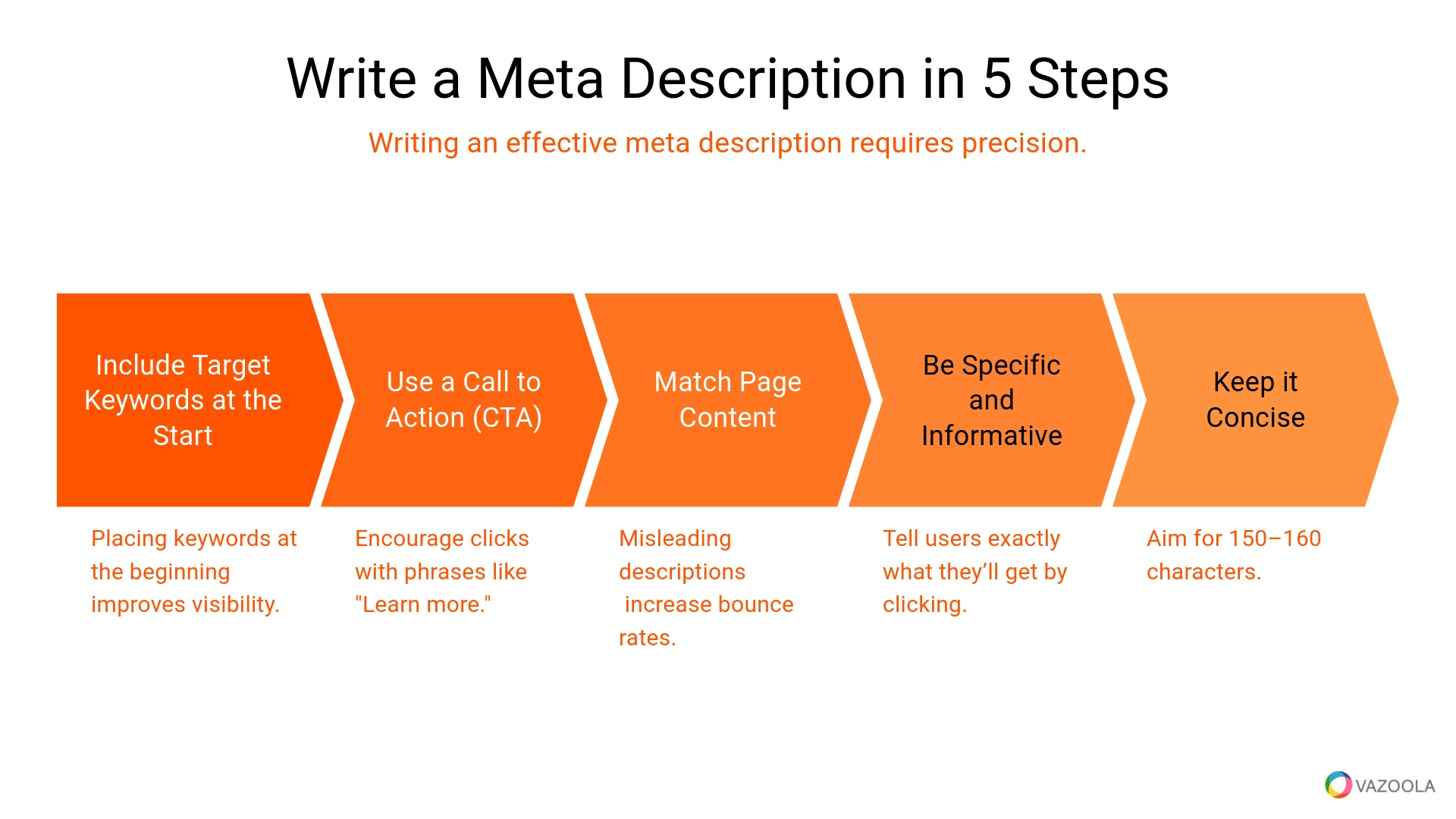
Here is an example of a well-optimized meta description. Notice its use of keywords, its relevance, and its CTA:

How Long Should a Meta Description Be?
If a meta description HTML is longer than 155 to 160 characters on desktop or 120 characters on mobile, Google will probably truncate it. That means that when meta descriptions are too long, search engines might cut them off, which leaves users with incomplete information.
A well-balanced meta description should be concise yet informative. If it’s too short, it may not provide enough context. Too long, on the other hand, and critical details could be lost to truncation.
So, what’s the perfect meta description length?
While there’s not a specific meta description character limit, per se, the ideal length falls between 150 to 160 characters, ensuring the description remains fully visible while engaging potential visitors. If yours is longer, make sure the most important details fall in the first 150 characters.
Even when you craft the perfect meta description, Google might still override it with a snippet pulled from the page – if that better matches a searcher’s query. To improve the chances of Google displaying your original description:
-
Keep it relevant to the page content.
-
Use keywords naturally, but avoid stuffing.
-
Make it engaging and actionable to encourage clicks.
Google’s own meta description tag provides a glimpse into what the search giant is looking for:

A strong meta description helps increase CTRs, even though it isn’t a direct ranking factor. Keep yours concise, compelling, and aligned with search intent to drive more traffic.
If you want to make sure yours falls within the optimal meta description length, use a meta description character count tools such as:
-
Google SERP Simulator – Visualize how meta descriptions appear in search results.
-
Yoast SEO Plugin – WordPress plugin that checks meta description length and keyword optimization.
-
VELOX Media – Analyzes and evaluates the length of meta descriptions in real time.
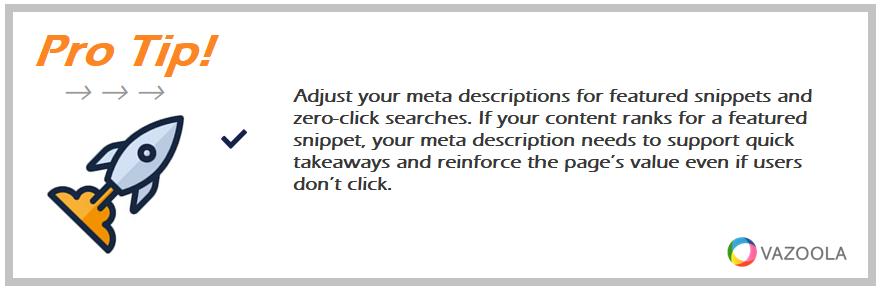
Adjust your meta descriptions for featured snippets and zero-click searches. If your content ranks for a featured snippet, your meta description needs to support quick takeaways and reinforce the page’s value even if users don’t click.
Meta Description Generators
Crafting the perfect meta description can be time-consuming, but AI-powered tools and SEO assistants can help streamline the process. Tools like Copy.ai and ChatGPT can generate descriptions based on your page content, keywords, and best practices. They help you produce concise and engaging snippets that encourage clicks.

What are some of the best meta description generators? You can try:
-
Copy.ai – Uses AI to generate compelling and persuasive meta descriptions.
-
Semrush Writing Assistant – Analyzes content and suggests optimized meta descriptions based on SEO best practices.
-
ChatGPT - A popular AI tool that generates meta descriptions based on prompts.
-
Jasper AI – Produces human-like descriptions tailored to search intent.
-
Rank Math – A WordPress plugin that provides real-time feedback on meta descriptions for SEO optimization.
While these tools provide great starting points, you should always review and refine any AI-generated descriptions so you can make sure they match user intent and accurately reflect your content. A well-optimized meta description is key to improving click-through rates and search visibility.
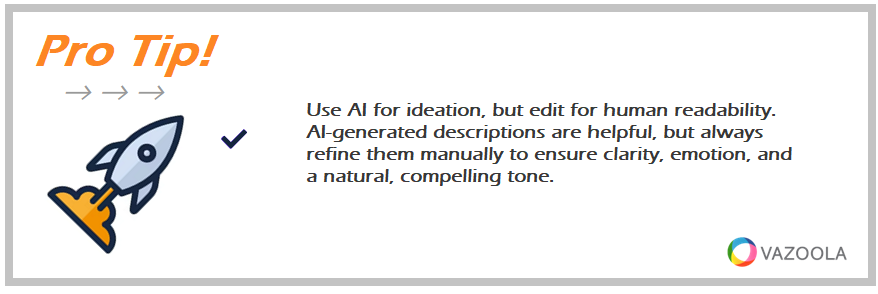
Use AI for ideation, but edit for human readability. AI-generated descriptions are helpful, but always refine them manually to ensure clarity, emotion, and a natural, compelling tone.
Meta Description Examples
Strong meta descriptions should be engaging, informative, and optimized for user intent. Below are examples of different meta description qualities:
Bad Meta Description (Too Generic)

Why it’s bad: Lacks detail, listing headings but doesn’t explain the value of the page.
Good Meta Description (Descriptive but Could Be Improved)

Why it’s good: Specific, and detailed, lets the user know what to expect, however is still truncated.
Best Meta Description (Optimized for Engagement)

Why it’s best: Uses a question to pique curiosity, includes a CTA, and highlights SEO benefits.
Boost Visibility and Engagement
A well-crafted meta description may not be a direct SEO ranking factor, but its impact on click-through rates is undeniable. When you keep your descriptions concise, relevant, and compelling, you can improve your business’s search visibility and engagement.
Using AI tools and SEO plugins can streamline the optimization process, but human oversight remains of utmost importance. Whether manually written or AI-assisted, a good meta description should always match search intent and encourage user interaction.

Test multiple meta descriptions with A/B split testing. Use tools like Google Ads to test different descriptions on PPC campaigns. Analyze which variations get higher CTRs, then apply those insights to organic meta descriptions.

